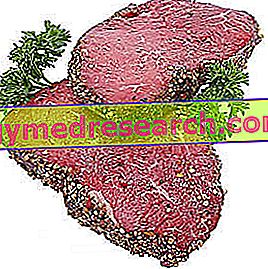Generality
The vagina is a musculo-membranous canal which, in women, unites the uterus with the external genitalia (vulva).
Belonging to the female genital apparatus, the vagina has a length of 8-10 centimeters and a slightly oblique orientation, which from above is directed downwards and forwards. Above it is inserted into the neck of the uterus, while at the bottom it passes through the pelvic floor and opens into the vestibule of the vulva.
The term vagina derives from the Latin vagina (literally "fodero" or "guaina").

Functions
The vaginal canal is very distensible; in normal conditions it is in fact collapsed (flattened antero-posterior), while it expands:
- during sexual intercourse, to receive the penis and receive the sperm;
- during childbirth, to allow the passage of the fetus and fetal appendages.
The vagina is therefore the female organ of mating ( copulatory organ ), but also a component of the birth canal . It also allows the passage of menstrual fluids .
Anatomy
Although in common language the two terms are often used as synonyms, the vagina should not be confused with the vulva ; the latter in fact represents the set of female external genitalia (shown in the figure below).
The vulva also houses the vaginal opening, that is the lower opening through which the vagina communicates outside. This orifice (also called introit) is placed in the vestibule of the perineum, in position immediately behind the urethral meatus (external opening of the urethra).

At the opposite end of the vaginal canal we find an enlargement corresponding to the region called the vaginal vault (or vaginal arch or fornix ), in which the vagina is fixed on the cervix. Here, the lower part of the uterus, called the uterine cervix, protrudes into the vagina with a dome-shaped formation called the tench muzzle.

Due to the aforementioned oblique orientation, the posterior part of the vagina is inserted on the uterine portal at a point higher than that in which the front wall is inserted; consequently, the posterior fornix is higher than the front one. For the same reason, the length of the back of the vagina (10-12 cm) is greater than that of the front (7-8cm).
During a complete sexual intercourse, the male sperm collects in the vaginal vault (therefore also known as receptaculum seminis ); from here the spermatozoa rise in the uterine orifice present in the cervical canal, until they enter the fallopian tubes to fertilize the egg cell.
 | 1) VAGINA |
| 2) ESOCERVICE | |
| 3) UTERO | |
| 4) FALLOPPIO TUBE | |
| 5) OVAIO | |
| 6) FIMBRIE | |
 |
HYMEN
In general, in virgin women the vaginal opening is more or less surrounded by the hymen; it is a membrane of connective tissue similar to a ring, which varies significantly from one woman to another in terms of size and thickness (in some women it comes for example to completely close the vaginal opening, see imperforate hymen ).
The rupture of the hymen (called defloration) generally occurs during the first sexual intercourse, but can also occur when doing sports (such as horse riding) or following local traumas, including manual ones.

Anatomical reports
We have already seen how the vagina is inserted superiorly on the neck of the uterus and opens, inferiorly, in the vestibule of the vulva.
Anteriorly, the vagina is related to the base of the bladder in its upper third and with the urethra in its lower part.
Later, the vagina is related to the peritoneal cavity (Douglas cable) in its upper third, with the rectum in its intermediate portion and with the perineum in the lower third.
Lubrication and sexual intercourse
The vaginal mucosa is covered by a non-keratinized stratified paved epithelium; this epithelium is typical of regions that have to bear an important mechanical stress and that for this reason are subject to a rapid turnover of surface cellular elements. In addition to the vagina, for example, we find this epithelium in the mucosa of the oral cavity and the esophagus.
There are no glands in the vaginal mucosa; consequently, the lubrication of the vaginal canal is entrusted to the fluid that exudes from the venous plexuses of the vaginal wall; during sexual intercourse, lubrication is greater as the venous vessels dilate in response to sexual arousal. To this is added also the lubricating activity of the cervical mucus, while as far as the lubrication of the vulva is concerned, above all the Bartolini glands intervene.
The vaginal fluid is also an important defense against pathogens and support for sperm activity.
Vaginal wrinkles
The mucous membrane of the vagina has transverse folds, arranged in series and called wrinkles or vaginal folds, which are more numerous and inferiorly developed. Their presence is important to guarantee the organ the aforementioned extensibility, which allows it for example to adapt to the size of the penis during a sexual relationship.
Following the simple sexual arousal, even without penetration, the vagina extends rapidly by about 8cm and expands also in width.
Like the uterus, the vaginal mucosa also undergoes characteristics and cyclic changes in response to the levels of estrogen and progesterone.
vaginal pH
Under normal conditions, the vagina is populated by different microorganisms, which are in a state of equilibrium between them. The most important bacteria in the vaginal ecosystem are the lactobacilli .
As in other districts, both the lactobacilli and the organism benefit from this mutual coexistence. The lactobacillary flora feeds on the glycogen present in vaginal transudations and returns the favor by synthesizing lactic acid. And it is thanks to lactic acid that the vaginal environment is kept slightly acidic, at a pH of about 3.8-4.5.
This acidity is particularly valuable and important for the body, as it hinders the growth of other pathogens responsible for vaginal infections.
Diseases of the vagina
The main diseases and the most common disorders affecting the vagina are:
- vaginitis: inflammation of the vaginal walls, often linked to sexually transmitted infections or fecal contamination of the uterus;
- bacterial vaginosis: inflammation of the vagina with a polymicrobial etiology; it means that a general alteration of the normal microbial flora contributes to its inflammation;
- vaginismus: involuntary spasm of the vaginal and perivaginal muscles in the moment of penetration of the penis or of the attempt - real or imaginary - of penetration; vaginismus makes sexual intercourse painful, if not impossible;
- vaginal prolapse: downward movement of the vaginal walls due to failure of the supporting structures and suspension of the vagina.



